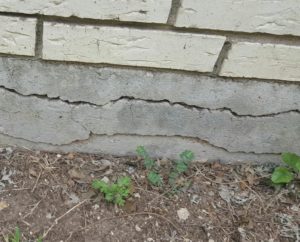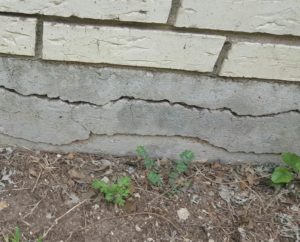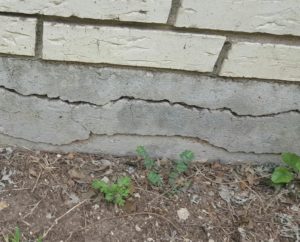Cracks in foundation are very critical for structures even if they are minor in nature. Foundations are typically built below ground level. Cracks can pose significant problems for the durability of concrete.
Why Foundation Cracks Are Serious
The foundation is the beginning of the structure. Foundation failure leads to failure of the entire structure. Following are the main problems with foundation cracks
- The crack could expose the reinforcement. In the presence of moisture and oxygen, the reinforcement may crack.
- Small cracks in concrete cause the width of the crack to increase due to expansion of the concrete and corrosion of the reinforcement.
- The durability of the structure depends on the durability of the concrete and reinforcements. Moisture can penetrate concrete through cracks, and harmful chemicals can damage concrete.
- The most important problem is structural failure. If the crack is large, it may affect the stability of the structure.
Types of Foundation Cracks
There are different types of cracks due to the behavior or type of construction of the foundation. Below are some of the cracks in the foundation.
- Horizontal cracks
Horizontal cracks in the foundation generally arise due to thermal influences. The stressed condition of the foundation can lead to the formation of this type of cracks. Also, water pressure, like. B. Water pressure leads to the formation of this type of cracks.
Such cracks can be avoided with adequate reinforcement.
- Vertical cracks
Vertical cracks in the foundation may indicate a structural defect or may have other causes, such as shrinkage effects, thermal effects, etc. Treatment of this type of cracks must be carried out in consultation with a civil engineer.
- Step cracks
Staggered cracks may be due to settlement of foundations or shrinkage effects of materials
- Diagonal cracks
Diagonal cracks may be due to shear failure or torsional effects in reinforced concrete elements. In masonry foundation walls, there may be failure due to shear, settlement, thermal effects, etc.
- Shrinkage Cracks
Shrinkage cracks occur in the early stages of concrete as it hardens. There are different types of concrete shrinkage .
In addition, shrinkage cracks can also occur in the masonry.
Reasons for Foundation Cracks
As explained in the following sections, there are many reasons for foundation cracks.
- Finishing the foundations
Foundation settling can cause cracks. Cracks in the foundation may be due to additional stresses created by settlement.
Furthermore, uneven stress distribution can cause cracking.
- Effects of expansive soil
Swollen soil expands when wet and shrinks when dry.
An increase in the earth column leads to an increase in pressure under the foundation. This pressure can even lift the anchoring system in small buildings.
Rubble foundations are not as stable as concrete foundations. They cannot withstand the upward pressure and break.
- Structural errors
The foundation can crack due to a structural failure. Insufficient structural capacity can result in structural failure. This can be considered a design flaw.
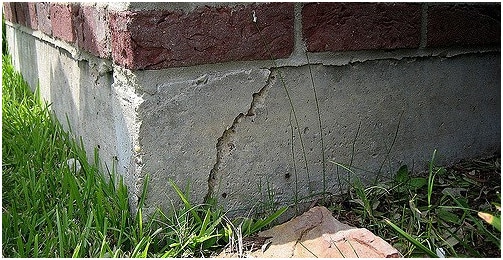
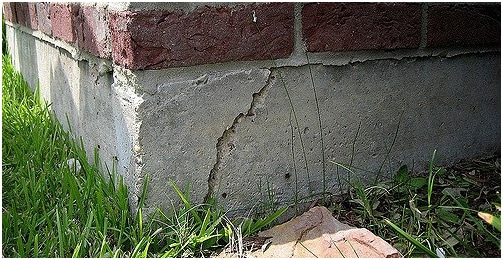
- Error
Planning and construction errors can cause foundation cracks.
- Reinforcement corrosion
Chemical attacks, such as sulfate and chloride attacks, can lead to reinforcement corrosion. This increases the volume around the reinforcement. This can cause cracks in the foundation.
- Thermal Cracks
Increasing the temperature of the foundation can cause cracks.
The increase in temperature due to the heat of hydration can cause cracking. The temperature difference between the core and the surface and the temperature gradient are the key factors in controlling crack formation.
Generally, the temperature difference and temperature gradient are maintained at around 25 0 C. Care must be taken to ensure that the temperature remains within these limits during construction.
- Delayed formation of ettringite
The increase in concrete temperature during the hydration process is inevitable. However, allowing temperatures to rise beyond a certain level is a big risk.
Generally, the temperature of thick concrete is maintained at around 70-75 0 C. As the temperature increases, properties can form over time. This is called delayed ettringite formation.
The formation of ettringite leads to swelling and cracks in the foundation.
How to Prevent Foundation Cracks
It is the designer's responsibility to evaluate soil and structure conditions during planning. Appropriate planning practices could avoid/minimize cracks in foundations.
- Cracks in the foundation due to thermal influences can be controlled by reinforcement. We generally provide foundations with a bottom reinforcing mesh. Increasing thickness can cause cracks in the reinforcement.
The width of the crack can be checked based on the quality of concrete used and reinforcement can be provided if necessary. If individual foundations are thicker than 500mm, crack control reinforcements can be installed.
- Concrete foundations are less prone to cracking due to expansive soil conditions. However, cracks can occur in rubble foundations built on extensive soils.
By using reinforced concrete beams or strips below the rubble foundation, the transfer of tensile stresses to the rubble foundation can be avoided. Proper construction of floor joists/beams also minimizes cracks of this type.
- By studying soil and groundwater, we become aware of chemical attacks. Since durability is an important concern, the concrete grade, water-cement ratio, and minimum cement content can be selected based on the exposure class and intended service life of the structure. This minimizes durability issues and resulting cracks in the foundation.
- Delayed ettringite formation can be avoided by reducing the heat of hydration of the concrete. Since the increase in heat in concrete is represented by temperature, we can monitor and control it.
Performing marking tests and collecting temperature data are helpful in making decisions. Furthermore, it is recommended to use cement with low thermal performance or mixed cement, such as: B. a combination of normal Portland cement and fly ash, etc., heat. Refrigeration units, use of cold water, night concreting, etc. also reduce temperature rise.
How to assess foundation cracks
Cracks can appear anywhere in the foundation. This could be due to any of the reasons mentioned above.
- The appearance of surface cracks at the top of the foundation may be due to thermal cracks. Depending on the width of the crack, the repair method should be selected. Furthermore, the exposure conditions of the structure can also be taken into account.
- Cracks in the rubble foundation with increasing crack width toward the base of the foundation may be due to settlement of the foundation.
- If the width of the frame increases in the upper area of the rubble foundation, this may be due to an upward movement of the soil due to its expansion.
- The crack may be caused by shear failure of the footings or foundation. It could form at the shear perimeter of the foundation. piercing scissors Cracks can be clearly visible and clearly identified.
- Stress cracks may occur due to reinforcement yielding. They occur in the stress plane of the structure.
How to Repair Foundation Cracks
The type of repair depends on the degree of crack formation and the load conditions in the subsoil.
- Concrete foundations
If the structure is in a hostile environment, all cracks must be carefully repaired.
Small cracks that have not penetrated the armor and are very narrow in width can be prepared from the surface. A V-shaped groove can be cut and filled with non-shrink construction mortar.
The wider crack could be sealed with epoxy mortar. When repairing, the standard method must be followed. Additionally, this method requires the use of pressure grouting.
- Rubble foundations
Repairing rubble foundations is a challenge. The proposed concrete method could also be used to repair rubble foundations.
Additionally, some changes could also be made. For example, if the building is built on extensive land, we may need to make some changes to the foundation to improve the bearing capacity.
Related articles
- Brick Cracks
- Structural Cracks
- Cracks in the basement wall
- Beam error
- Foundation failure
- Types of Spine Defects

